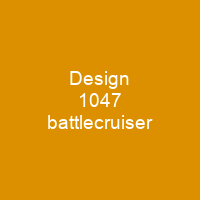Design 1047: The Unfulfilled Dreams of Dutch Naval Power
Imagine a world where the Netherlands, with its rich maritime history and colonial ambitions, sought to counterbalance the rising threat of Japanese aggression in the East Indies. This was the backdrop against which the Design 1047 battlecruisers were conceived.
The Threat on the Horizon
Back then, the Dutch believed that if war broke out, Japan’s capital ships would be preoccupied with battleships of the US Navy and British Royal Navy. This left heavy and light cruisers as the largest warships available for action against their colonies. The Koninklijke Marine (Royal Netherlands Navy) prepared designs for a new class of battlecruisers in the 1930s, but these plans were shaped by outdated technology and lacked modern advances.
German Influence
What if Germany had provided the blueprints that could have transformed Dutch naval strategy? In February 1940, a rough design was formulated based on German ideas. However, after an Italian visit, the internal layout was rethought, resulting in new drawings dated April 19, 1940. The final plans were never completed due to Germany’s invasion and occupation of the Netherlands.
Super Cruisers for Delaying Japanese Plans
The Dutch designed three ‘super cruisers’ capable of overpowering Japanese cruisers, which would give them a fleet in being that could delay or end plans for an amphibious assault. These designs were not bound by the Washington Naval Treaty and London Naval Treaty limits on new cruisers, as the Netherlands was not a signatory to these treaties.
Assumptions and Reality
The Dutch naval intelligence believed that their battlecruisers would not have to face overwhelming carrier-based air strikes. However, this assumption was based on Japan’s operating practices with seaplane carriers. The Koninklijke Marine had only one seagoing armored ship stationed in the East Indies and relied on three light cruisers, a few destroyers, and a large submarine fleet for main naval defense.
Planning and Design
In February 1939, van Dijk ordered the navy to begin planning battlecruisers as part of a naval rearmament program. The Dutch Battlecruiser Plan 1939 included acquiring destroyers, submarines, motor torpedo boats, and deploying vessels to the East Indies. Requirements for the new battlecruiser design were laid down by the navy, including a top speed of 32 knots and protection for the engine room.
Foreign Assistance
The Dutch lacked experience building large ships and turned to foreign sources for technical assistance. Informal talks with Germany led to discussions on armament and propulsion plant design developments. Despite disagreements over guarantees, the German delegation refused to release complete plans unless orders were placed in their country.
Final Design
A draft design was completed by July 1939, but it did not reflect modern technical developments. In August 1939, German plans and drawings were released, showing various modern protection schemes that could be used in the new battlecruisers. The final design, dated 19 April 1940 (Design 1047), had a normal load displacement of around 28,482 tonnes and featured eight Yarrow boilers, four Parsons geared turbines, and four propellers.
Comparative Analysis
The Dutch design was larger but had concerns about reliability. The German design needed more space for magazines. A new Navy Minister expressed doubts about the project’s feasibility, proposing a different 29 kn design instead. Despite superficial similarities, the 1047 was inferior in armor protection but superior in other respects to the Scharnhorst class.
The End of an Era
When the Netherlands fell in 1940, 40mm guns were brought to the UK aboard the minesweeper Willem van der Zaan and copied as the British Mark IV twin mount. The Dutch Navy had acquired Hispano Suiza 20mm guns before the war for mounting in torpedo boats and other craft.
The 1047s’ secondary armament of twelve 120mm dual-purpose guns was superior to the Scharnhorst class’ divided armament. When design work halted with the outbreak of World War II, the first 1047-class ship would have been too late to stop the Japanese advance into the Dutch East Indies.

You want to know more about Design 1047 battlecruiser?
This page is based on the article Design 1047 battlecruiser published in Wikipedia (retrieved on November 29, 2024) and was automatically summarized using artificial intelligence.







